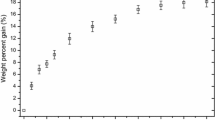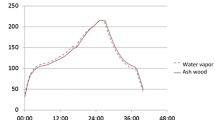Abstract
Acetylated wood was exposed to decay by brown, white and soft rot in order to address the sorption behaviour of decayed wood. The sorption isotherms were analysed using the Hailwood–Horrobin model. It was found that the different types of decay exhibit different sorption properties. Brown rot decayed wood exhibits significantly lower hygroscopicity in both total, monomolecular and polymolecular sorption. Soft rot decayed wood followed the same pattern as the brown rot decayed wood; however, the reduction in hygroscopicity was not significant. White rot decayed wood showed a different behaviour, with increased hygroscopicity in total and polymolecular sorption and decreased hygroscopicity in monomolecular sorption.



Similar content being viewed by others
References
Anagnost SE, Smith WB (1997) Hygroscopicity of decayed wood: Implications for weight loss determination. Wood Fiber Sci 29:299–305
Chauhan SS, Nagaveni HC (2010) Moisture adsorption behaviour of decayed rubber wood. J Inst Wood Sci 19:1–6
Cowling EB (1961) Comparative biochemistry of the decay of sweetgum sapwood by white rot and brown rot fungus. USDA Forest Service, Technical Bulletin No 1258
Eaton R, Hale MDC (1993) Wood, decay, pests and protection. Chapman and Hall, London
Hailwood AJ, Horrobin S (1946) Absorption of water by polymers: analysis in terms of a simple model. Trans Far Soc 42B:84–102
Papadopoulos AN (2010) Chemical modification of solid wood and wood raw materials for composites production with linear chain carboxylic acid anhydrides: a brief Review. Bioresources 5(1):499–506
Papadopoulos AN, Hill CAS (2002) The biological effectiveness of wood modified with linear chain carboxylic acid anhydrides against Coniophora puteana. Holz Roh- Werkst 60:329–332
Papadopoulos AN, Hill CAS (2003) The sorption of water vapour by anhydride modified softwood. Wood Sci Technol 37:221–231
Papadopoulos AN, Pougioula G (2010) Mechanical behaviour of pine wood chemically modified with a homologous series of linear chain carboxylic acid anhydrides. Bioresour Technol 101:6147–6150
Papadopoulos AN, Militz H, Pfeffer A (2010) The biological behaviours of pine wood chemically modified with linear chain carboxylic acid anhydrides against soft rot fungi. Int Biodeterior Biodegradation 64:409–412
Rowell RM (1983) Chemical modification of wood. For Prod Abstr 6:366–382
Skaar C (1988) Wood-water relationships. Springer, Berlin
Spalt HA (1958) The fundamentals of water vapour sorption by wood. For Prod J 8(10):288–295
Stamm AJ, Tarkow H (1950) Penetration of cellulose fibers. J Phys Colloid Chem 54:745–753
Tsoumis G (1992) Science and technology of wood: structure, properties, utilization. Van Nostrand Reinhold, New York
Author information
Authors and Affiliations
Corresponding author
Additional information
This paper is dedicated to Prof. Dr. Ioannis A. Kakaras for his retirement.
Rights and permissions
About this article
Cite this article
Papadopoulos, A.N. Sorption of acetylated pine wood decayed by brown rot, white rot and soft rot: different fungi—different behaviours. Wood Sci Technol 46, 919–926 (2012). https://doi.org/10.1007/s00226-011-0450-y
Received:
Published:
Issue Date:
DOI: https://doi.org/10.1007/s00226-011-0450-y




